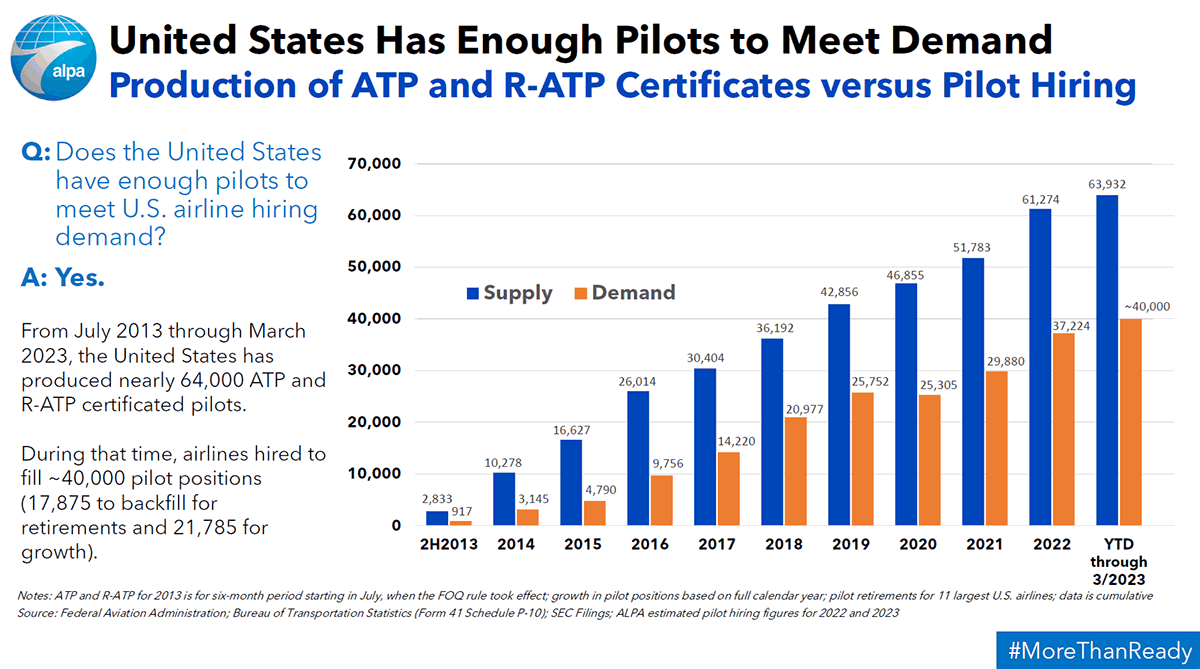Release #: 23.11
April 19, 2023
U.S. Pilot Production Remains Strong According to New FAA Data
10-Year Trend Has Produced Nearly 64,000 Pilots—More Than Airlines Hired
Washington, D.C.—The Air Line Pilots Association, Int’l (ALPA) today released the latest data from the Federal Aviation Administration (FAA) showing that pilot production remains strong and reaffirming that the United States continues to have more pilots in the market today than pilot jobs available. The FAA has certificated 2,658 new airline pilots in just the first three months of this year. Since new, stronger pilot safety training standards were put into place in 2013, 63,932 individuals have been certificated as airline pilots, while mainline airline carriers filled approximately 40,000 pilot positions over the same timeframe. Also over that same time, airline passenger fatalities have dramatically reduced.
“Over the past 10 years, the United States has not only reduced airline passenger fatalities but also produced more than enough pilots to meet airline hiring demand,” said Capt. Jason Ambrosi, ALPA president. The groups that continue the flood of misinformation and misleading data are only interested in one thing: manufacturing a crisis to lower aviation safety standards and increase their bottom line.”
Capt. Ambrosi will testify before the House Aviation Subcommittee this morning, emphasizing that pilot production is high enough to sustain the industry, without weakening safety standards as some special interests are suggesting under the guise of pilot supply issues.

With Congress currently drafting legislation for the FAA reauthorization, segments of the industry are once again suggesting there is an issue with pilot supply. They want to weaken the lifesaving safety improvements included in the passage of the Airline Safety and Federal Aviation Administration Extension Act of 2010, which has led to a 99.8 percent reduction in airline passenger fatalities since it was enacted in 2013. This narrative that the United States does not have enough pilots does not reflect reality; rather, it underscores these parties’ real goal: weakening proven safety standards so they can hire less qualified aviators for lower pay and benefits.
During the pandemic, airlines made decisions to bump pilots to smaller equipment, park aircraft, and furlough and put pilots on inactive status, all leading to a significant training backlog. When demand—and subsequently growth—returned more quickly than some airlines anticipated, most of these pilots had to be retrained. Retraining is time-intensive and expensive. It also relies on a training footprint that includes personnel and simulator devices and was not designed for a global pandemic.
Responding to industry problems that arose during the pandemic with permanent changes to pilot training and qualification requirements is ill-considered and dangerous. Attempts to undermine or otherwise alter or repeal the lifesaving set of requirements established in 2010, including moving from an experiential-based training and qualification regime to a simulation-based system, threatens the traveling public and should be summarily rejected. The current production of certificated pilots has outpaced U.S. airline hiring needs to replace retiring pilots and has also covered the new hiring demand created by flying increases before the pandemic and today.
Founded in 1931, ALPA is the largest airline pilot union in the world and represents more than 67,000 pilots at 39 U.S. and Canadian airlines. Visit ALPA.org or follow us on Twitter @ALPAPilots.
-###-
CONTACT: ALPA Media, 703-481-4440 or Media@alpa.org

